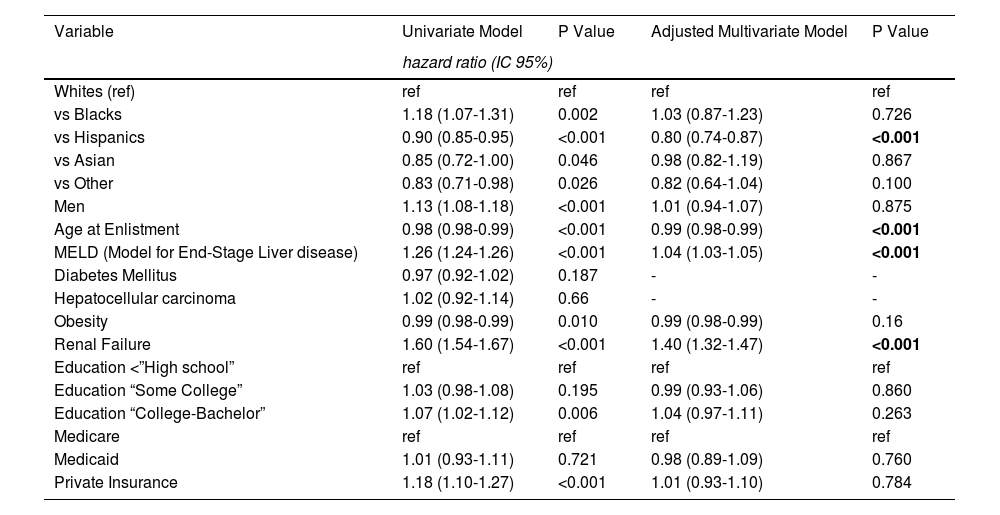
Abstracts of the 2022 Annual Meeting of the ALEH
Más datosthere are different variables in patients with alcohol associated liver disease (ALD) and enlisted patients for liver transplant (LT), such as ethnicity, that determine health disparities in access, morbidity and mortality. This study aimed to assess and measure the impact of ethnicity in ALD and patients enlisted for LT.
Materials and Methodswe conducted a retrospective study using U.S databases, the National Health and Nutrition Examination Survey (NHANES) and the United Network for Organ Sharing (UNOS) from 2011 to 2018. We created a multivariate model analyzing the clinical characteristics of the interviewed patients for NHANES. Alcohol consumption and ethnicity were self-reported. We also created a competing risks model for time to LT in enlisted patients.
Resultsof the 39,156 interviewed patients, 17.1% identified as Hispanic. In this group, the prevalence of ALD was 9.0% and the average consumption of pure alcohol was 2.3 L/year. The multivariate-adjusted model showed that Hispanics were independently associated with a higher risk of ALD (OR 1.30; 95%CI: 1.05-1.60, p=0.018). Of the enlisted patients, 13.6% were Hispanic. White ethnicity, lower age, male sex, higher MELD score, renal failure, lower BMI, higher education and private insurance were associated with a higher rate of LT. Hispanics were independently associated with a lower LT (HR 0.80; 95%CI: 0.74-0.87, p<0.001).
Conclusionsethnicity is an important factor in healthcare outcomes. This is a growing area of interest, and research should be carried out to better our understanding of the impact that these disparities have on patients. Studying ethnic minority groups is needed to enable researchers to face the challenges of reducing and ultimately eliminating health disparities.
Tabla 1. Competitive Risk Model for Patients Enlisted for Liver Transplant
| Variable | Univariate Model | P Value | Adjusted Multivariate Model | P Value |
|---|---|---|---|---|
| hazard ratio (IC 95%) | ||||
| Whites (ref) | ref | ref | ref | ref |
| vs Blacks | 1.18 (1.07-1.31) | 0.002 | 1.03 (0.87-1.23) | 0.726 |
| vs Hispanics | 0.90 (0.85-0.95) | <0.001 | 0.80 (0.74-0.87) | <0.001 |
| vs Asian | 0.85 (0.72-1.00) | 0.046 | 0.98 (0.82-1.19) | 0.867 |
| vs Other | 0.83 (0.71-0.98) | 0.026 | 0.82 (0.64-1.04) | 0.100 |
| Men | 1.13 (1.08-1.18) | <0.001 | 1.01 (0.94-1.07) | 0.875 |
| Age at Enlistment | 0.98 (0.98-0.99) | <0.001 | 0.99 (0.98-0.99) | <0.001 |
| MELD (Model for End-Stage Liver disease) | 1.26 (1.24-1.26) | <0.001 | 1.04 (1.03-1.05) | <0.001 |
| Diabetes Mellitus | 0.97 (0.92-1.02) | 0.187 | - | - |
| Hepatocellular carcinoma | 1.02 (0.92-1.14) | 0.66 | - | - |
| Obesity | 0.99 (0.98-0.99) | 0.010 | 0.99 (0.98-0.99) | 0.16 |
| Renal Failure | 1.60 (1.54-1.67) | <0.001 | 1.40 (1.32-1.47) | <0.001 |
| Education <”High school” | ref | ref | ref | ref |
| Education “Some College” | 1.03 (0.98-1.08) | 0.195 | 0.99 (0.93-1.06) | 0.860 |
| Education “College-Bachelor” | 1.07 (1.02-1.12) | 0.006 | 1.04 (0.97-1.11) | 0.263 |
| Medicare | ref | ref | ref | ref |
| Medicaid | 1.01 (0.93-1.11) | 0.721 | 0.98 (0.89-1.09) | 0.760 |
| Private Insurance | 1.18 (1.10-1.27) | <0.001 | 1.01 (0.93-1.10) | 0.784 |









